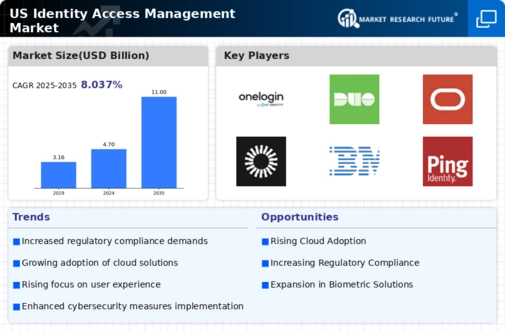The iot identity-access-management market is characterized by a dynamic competitive landscape, driven by the increasing demand for secure and efficient management of identities across interconnected devices. Key players such as Microsoft (US), IBM (US), and Amazon (US) are at the forefront, each adopting distinct strategies to enhance their market positioning. Microsoft (US) emphasizes innovation through its Azure Active Directory, focusing on seamless integration with IoT devices, while IBM (US) leverages its extensive experience in enterprise security to offer robust identity solutions tailored for IoT environments. Amazon (US), with its AWS platform, prioritizes scalability and flexibility, catering to a diverse range of industries. Collectively, these strategies foster a competitive environment that is increasingly focused on technological advancement and customer-centric solutions.
In terms of business tactics, companies are increasingly localizing their operations to better serve regional markets, optimizing supply chains to enhance efficiency. The market structure appears moderately fragmented, with several key players exerting considerable influence. This fragmentation allows for a variety of solutions and innovations, as companies strive to differentiate themselves in a crowded marketplace. The collective influence of these major players shapes the competitive dynamics, pushing for continuous improvement and adaptation to emerging trends.
In October 2025, Microsoft (US) announced a strategic partnership with a leading IoT device manufacturer to enhance its identity management capabilities. This collaboration aims to integrate advanced security features directly into IoT devices, thereby streamlining user authentication processes. The strategic importance of this move lies in its potential to set a new standard for security in IoT, positioning Microsoft (US) as a leader in the integration of identity management and IoT technology.
In September 2025, IBM (US) launched a new suite of identity management tools specifically designed for IoT applications. This initiative focuses on leveraging AI to automate identity verification processes, thereby reducing the risk of unauthorized access. The significance of this development is profound, as it not only enhances security but also improves operational efficiency, allowing businesses to scale their IoT deployments with confidence.
In August 2025, Amazon (US) expanded its AWS Identity and Access Management (IAM) services to include enhanced features for IoT devices. This expansion is indicative of Amazon's commitment to providing comprehensive security solutions that cater to the unique challenges posed by IoT environments. The strategic importance of this move lies in its ability to attract a broader customer base, particularly among enterprises looking to secure their IoT ecosystems.
As of November 2025, current competitive trends in the iot identity-access-management market are heavily influenced by digitalization, sustainability, and the integration of AI technologies. Strategic alliances are increasingly shaping the landscape, as companies recognize the value of collaboration in addressing complex security challenges. Looking ahead, competitive differentiation is likely to evolve, with a shift from price-based competition to a focus on innovation, technological advancement, and supply chain reliability. This transition underscores the importance of developing unique solutions that not only meet customer needs but also anticipate future demands in an ever-evolving digital landscape.
























Leave a Comment